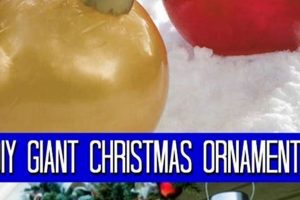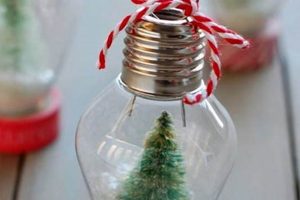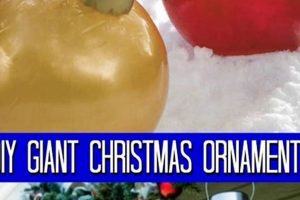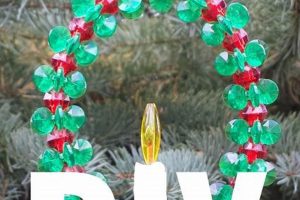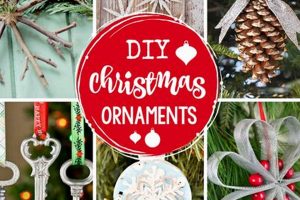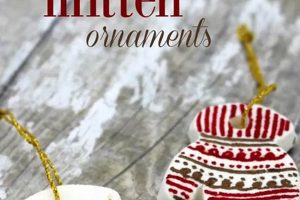Handcrafted adornments for Yuletide trees created from natural conifer fruit, often personalized through paints, glitter, ribbons, and other decorative elements, exemplify a sustainable and creative approach to holiday decorating. These items offer an alternative to mass-produced ornaments. For example, families can gather pine cones during nature walks and transform them into unique keepsakes.
The practice of creating such decorations offers numerous advantages. It promotes environmental consciousness by utilizing readily available natural materials. It also fosters creativity and provides an engaging activity for individuals of all ages. Historically, using natural elements for holiday embellishments reflects a connection to nature and resourcefulness, predating the commercialization of Christmas decorations.
The remainder of this discourse will explore various methods for crafting these personalized decorations, outlining necessary materials, step-by-step instructions, and inspirational design ideas for transforming simple pine cones into festive tree ornaments.
Crafting Superior Pine Cone Decorations
Achieving visually appealing and durable decorations requires careful planning and execution. The following guidelines will assist in creating ornaments of lasting quality.
Tip 1: Material Selection: Choose mature, undamaged cones. Inspect for insects or debris. The structural integrity of the cone is critical for long-term use.
Tip 2: Preparation is Paramount: Thoroughly clean the cones. Baking at a low temperature (approximately 200F or 93C) for 30-60 minutes will eliminate potential pests and open the scales for improved adhesion of decorative materials.
Tip 3: Adhesive Selection: Employ a high-quality adhesive suitable for porous surfaces. Hot glue provides a strong and rapid bond, while craft glue offers a longer working time. Consider the type of materials being adhered when selecting an adhesive.
Tip 4: Finishes and Sealants: Apply a sealant to protect the finished product from moisture and dust. A clear varnish or acrylic spray can enhance durability and prevent discoloration over time. Ensure adequate ventilation during application.
Tip 5: Secure Hanging Mechanisms: Affix a robust hanging loop or hook. Wire or sturdy twine are suitable options. Ensure the attachment point is securely bonded to the cone to prevent accidental breakage and ornament loss.
Tip 6: Consider Proportion and Balance: When adding embellishments, maintain visual balance. Overcrowding can detract from the natural beauty of the cone. Consider the overall size and shape of the cone when selecting adornments.
Tip 7: Drying Time: Allow sufficient drying time for adhesives and finishes before handling or storing the finished ornaments. Premature handling can result in smudging or detachment of decorative elements.
Adhering to these best practices ensures the creation of durable, aesthetically pleasing, and long-lasting decorations suitable for holiday display.
The subsequent section will address storage solutions for these handcrafted ornaments, preserving their integrity for future seasons.
1. Natural Material Selection
Natural material selection directly impacts the aesthetic outcome, structural integrity, and overall sustainability of handcrafted coniferous fruit decorations for Yuletide trees. The selection process initiates the project; the chosen pine cones dictate the scale, texture, and inherent form of the final ornament. For example, using cones gathered from a specific species of pine tree, such as the Eastern White Pine, yields smaller, more delicate ornaments suitable for miniature trees. Conversely, cones from the Ponderosa Pine offer a larger canvas for more elaborate designs. The absence of proper selection leads to flawed materials and ultimately lower-quality decorations.
The physical condition of the collected cones is crucial. Cones exhibiting signs of decay, insect infestation, or damage will compromise the stability and longevity of the resulting decoration. A real-world example illustrating this point involves the use of cones collected from the forest floor without proper inspection. These cones may contain latent fungal growth, which can manifest over time, causing discoloration and structural weakening of the ornament. A practical application of this understanding lies in the implementation of a thorough inspection process prior to initiating the crafting phase, discarding unsuitable specimens.
In summary, judicious natural material selection is a foundational element in the successful creation of handcrafted coniferous decorations. The choice of cone species and assessment of physical condition exert a direct influence on the ornament’s aesthetic appeal, durability, and resistance to degradation. Overlooking this critical step can result in compromised decorations that fail to meet desired quality standards, underscoring the importance of prioritizing careful cone selection in the broader context of DIY Christmas tree ornaments.
2. Proper Cone Preparation
The relationship between proper cone preparation and the successful creation of handcrafted coniferous decorations for Yuletide trees is causal. Effective preparation directly determines the quality, longevity, and aesthetic appeal of the final ornament. Neglecting preparatory steps leads to compromised results. For instance, unprocessed cones may harbor insects that subsequently emerge and damage the decoration, or latent moisture that encourages mold growth, degrading the material and causing discoloration. Baking the cones at a low temperature serves as both sterilization and drying agent, mitigating these risks. The proper procedure increases the likelihood of successful adhesion of paints, glitter, or other embellishments. The lack of preparation is a fundamental flaw.
A specific example underscores the importance of these steps. Consider a scenario where untreated cones are adorned with delicate glitter and sealant. Over time, the moisture content within the cone causes the scales to constrict and distort, dislodging the decorative elements. Proper baking eliminates this moisture, ensuring dimensional stability and maintaining the integrity of the embellishments. The structural integrity of the pine cone, enhanced through proper preparation, also facilitates secure attachment of hanging mechanisms, preventing ornament detachment from the tree.
In conclusion, proper cone preparation is a non-negotiable prerequisite for crafting superior handcrafted Christmas tree ornaments. It addresses potential biological contamination, ensures structural stability, and promotes optimal adhesion of decorative materials. The time invested in these preparatory steps translates directly into the long-term quality and visual appeal of the finished ornaments. Failure to acknowledge and implement these procedures risks jeopardizing the entire crafting endeavor, undermining the effort and resources invested in creating these festive decorations.
3. Adhesive Bond Strength
Adhesive bond strength is a critical determinant of the durability and longevity of handcrafted coniferous fruit decorations for Yuletide trees. The robustness of the adhesive bond directly influences the ornament’s ability to withstand handling, storage, and display, contributing to its overall lifespan. A weak adhesive bond inevitably leads to the detachment of decorative elements, compromising the aesthetic integrity of the ornament and potentially rendering it unusable. For example, glitter, beads, or ribbons affixed with inadequate adhesive are prone to separation, especially under fluctuating temperature or humidity conditions common during the holiday season.
The selection of an appropriate adhesive is paramount. Factors such as material compatibility, drying time, and bond strength under various environmental conditions must be considered. Hot melt adhesives, for instance, provide a rapid and strong bond suitable for attaching larger or heavier embellishments. However, their rigidity may render them less suitable for delicate materials. Conversely, craft glues offer greater flexibility and are appropriate for finer details, but often require extended drying times and may possess lower initial bond strength. In a practical setting, the improper selection of adhesive may result in ornaments that appear aesthetically pleasing upon initial creation but subsequently degrade due to adhesive failure. Proper research and testing of adhesive options are essential for long-term success.
In summary, adhesive bond strength is an indispensable element in the creation of robust and enduring handcrafted coniferous ornaments. The careful selection and application of a compatible and high-strength adhesive ensures that decorative elements remain securely affixed, preserving the ornament’s aesthetic value and structural integrity over time. Addressing this aspect proactively mitigates the risk of premature failure and enhances the overall quality and sustainability of these festive decorations.
4. Decorative Element Choice
Decorative element choice directly influences the aesthetic outcome and perceived value of handcrafted coniferous fruit decorations for Yuletide trees. The selection of embellishments dictates the ornament’s style, ranging from rustic and natural to ornate and extravagant. The causal relationship is evident: the chosen elements determine the final visual impression and, consequently, the ornament’s suitability for specific decorative themes. For example, incorporating natural twine, burlap, and muted tones evokes a farmhouse aesthetic, while iridescent glitter, metallic paint, and faceted beads lend a more glamorous appeal. The absence of deliberate element selection results in a disjointed and aesthetically unappealing ornament.
The importance of decorative element choice extends beyond mere aesthetics. The selected materials also impact the ornament’s perceived quality and value. Utilizing high-quality, durable materials enhances the ornament’s longevity and imparts a sense of sophistication. For instance, employing glass beads rather than plastic alternatives elevates the ornament’s visual appeal and resistance to wear and tear. Similarly, using acid-free craft paints ensures colorfastness and prevents fading over time. In practical applications, carefully curated decorative element collections can be offered as kits, catering to specific aesthetic preferences and simplifying the crafting process for consumers.
In summary, decorative element choice is an integral component of crafting visually compelling and enduring coniferous fruit ornaments. The careful selection of materials not only shapes the ornament’s aesthetic but also influences its perceived quality and longevity. A deliberate approach to element selection enhances the overall crafting experience and ensures the creation of ornaments that align with desired aesthetic themes and maintain their beauty for years to come. Challenges in this area often involve balancing cost, durability, and aesthetic appeal, requiring thoughtful consideration of material properties and design principles.
5. Finishing Coat Application
Finishing coat application represents a crucial step in the creation of durable and visually appealing coniferous fruit decorations. Its influence on the longevity and aesthetic preservation of these ornaments cannot be overstated. The application of a suitable protective layer directly mitigates environmental damage, safeguarding against moisture absorption, dust accumulation, and ultraviolet radiation exposure. This protective barrier effectively seals the underlying decorative elements, preventing their degradation and maintaining their original vibrancy. For example, unsealed glitter is prone to flaking and detachment, while unprotected paint may fade or discolor over time. The finishing coat acts as a buffer, extending the ornament’s lifespan and ensuring its aesthetic integrity across multiple holiday seasons. Properly executed, this application transforms a vulnerable creation into a resilient and enduring keepsake.
The selection of an appropriate finishing coat is paramount. Options range from clear acrylic sprays to polyurethane varnishes, each possessing distinct properties affecting the final outcome. Acrylic sprays offer ease of application and relatively quick drying times, rendering them suitable for general protection. Polyurethane varnishes provide a more robust and durable finish, enhancing resistance to scratches and abrasions, but typically require longer drying periods and meticulous application techniques. The choice of finish should align with the specific decorative elements employed and the desired level of protection. For instance, ornaments adorned with delicate watercolor paints may benefit from a UV-resistant varnish to prevent fading, while those embellished with durable acrylic paints may require only a light acrylic spray for basic protection. Ignoring this consideration often results in a compromised finish that fails to provide adequate protection or detracts from the overall aesthetic appeal.
In summary, finishing coat application is an essential process in the fabrication of high-quality and long-lasting coniferous fruit ornaments. Its primary function is to shield the underlying decorative elements from environmental degradation, ensuring their continued beauty and structural integrity. Careful selection of a suitable finishing coat and diligent application techniques are critical for achieving optimal results. While challenges may arise in selecting the appropriate finish for diverse decorative materials, the benefits of this protective layer far outweigh the effort involved, resulting in ornaments that retain their festive charm for years to come. The failure to adequately seal and protect these ornaments is a significant oversight that diminishes their value and lifespan.
6. Hanging Mechanism Security
The structural integrity of a handcrafted coniferous ornament is directly linked to the security of its hanging mechanism. This facet dictates the ornament’s ability to remain affixed to the tree, serving as the primary determinant of its visibility and contribution to overall festive decoration. The selection and secure attachment of the hanging mechanism prevent accidental falls, which can result in damage to the ornament itself or surrounding decorations. For instance, a poorly secured hook on a heavier pine cone ornament will likely detach under the influence of gravity, causing the ornament to plummet and potentially shatter upon impact. The hanging mechanism is not merely an accessory; it is an integral component upon which the ornament’s functional success relies.
Practical applications of this understanding manifest in several ways. Craftspeople must consider the weight and balance of the finished ornament when selecting a hanging mechanism. Lightweight ornaments may suffice with simple twine loops, while heavier or more intricate designs necessitate sturdier wire hooks or eyelets. Furthermore, the attachment method is crucial. Adhesives, if used, must be compatible with both the cone material and the hanging mechanism. Mechanical fasteners, such as screws or eye pins, offer a more secure alternative but require careful execution to avoid splitting the cone. A real-world example involves attaching a wire loop to a pine cone using only hot glue. Over time, temperature fluctuations can weaken the glue bond, leading to detachment. Conversely, embedding the wire loop within a resin or epoxy provides a far more durable and reliable connection.
In summary, hanging mechanism security represents a fundamental aspect of crafting durable and visually pleasing coniferous ornaments. A secure attachment ensures that the ornament remains safely displayed, maximizing its contribution to the overall aesthetic and minimizing the risk of damage. Challenges often arise in balancing aesthetics with functionality, as the hanging mechanism should be discreet yet robust. Overcoming these challenges requires careful consideration of material properties, attachment techniques, and the overall weight and balance of the finished ornament. Neglecting this critical component undermines the effort invested in crafting the ornament itself.
7. Storage Technique Optimization
The long-term preservation of handcrafted coniferous ornaments relies heavily on optimized storage techniques. Improper storage directly contributes to the degradation of materials, compromising the aesthetic integrity and structural stability of these decorations. The effectiveness of the crafting process is undermined if the finished ornaments are not adequately protected during periods of non-use. For instance, exposure to humidity encourages mold growth, discoloration, and the loosening of adhered embellishments. Conversely, extreme dryness can cause pine cones to become brittle and prone to breakage. Storage technique optimization mitigates these risks, extending the lifespan of the ornaments and preserving their quality for future use.
Practical application of optimized storage includes several key considerations. Ornaments should be stored in a cool, dry, and dark environment, away from direct sunlight and temperature fluctuations. Acid-free tissue paper or bubble wrap provides cushioning and prevents abrasion between ornaments during storage. Individual storage containers or compartmentalized boxes further minimize the risk of damage. An illustrative example involves storing unprotected pine cone ornaments in a damp basement. Over time, the ornaments become moldy, the glitter dulls, and the attached ribbons fray, rendering them unusable. In contrast, ornaments stored in airtight containers with desiccant packets remain pristine, retaining their original beauty and structural integrity.
In summary, storage technique optimization is an indispensable element in the overall lifecycle of handcrafted coniferous decorations. It safeguards against environmental degradation, preserving the aesthetic and structural qualities of the ornaments. While challenges may arise in procuring suitable storage materials or allocating sufficient storage space, the benefits of implementing optimized storage practices far outweigh the associated costs. Neglecting this critical step diminishes the value of the crafting effort, ultimately leading to premature deterioration and loss of these festive decorations. The efficacy of careful crafting is nullified without equivalent care in storage.
Frequently Asked Questions
This section addresses common inquiries regarding the creation, care, and longevity of handcrafted coniferous fruit decorations.
Question 1: How can the accumulation of dust on coniferous decorations be effectively addressed?
Periodic cleaning with a soft-bristled brush or compressed air can remove dust. Avoid using liquid cleaners, which may damage delicate embellishments or weaken adhesive bonds.
Question 2: What are the primary indicators of insect infestation in coniferous cones used for crafting?
Signs of infestation include small holes, sawdust-like residue, or the presence of live insects. Baking the cones prior to crafting mitigates this risk.
Question 3: What types of adhesives are most suitable for adhering embellishments to porous coniferous surfaces?
Hot melt adhesives and craft glues designed for porous materials provide strong and durable bonds. Consider material compatibility and drying time when selecting an adhesive.
Question 4: How can the discoloration of coniferous decorations over time be prevented?
Applying a sealant or varnish containing ultraviolet (UV) inhibitors can protect against fading and discoloration caused by sunlight exposure.
Question 5: What are the recommended storage conditions for handcrafted coniferous decorations?
Store ornaments in a cool, dry, and dark environment. Enclosed containers or acid-free tissue paper can provide additional protection against damage and moisture.
Question 6: How can the structural integrity of aged coniferous decorations be assessed and reinforced?
Carefully inspect ornaments for loose components or weakened adhesive bonds. Reinforce weak points with fresh adhesive or replace damaged elements as needed.
Effective creation and maintenance of these ornaments involves consistent monitoring and care.
The following section will provide advanced design techniques.
DIY Pine Cone Christmas Tree Ornaments
This discourse has explored the multifaceted nature of DIY pine cone Christmas tree ornaments, emphasizing the importance of material selection, proper preparation, adhesive considerations, decorative element choices, finishing techniques, hanging mechanism security, and storage optimization. Each of these elements contributes significantly to the aesthetic appeal, durability, and long-term viability of these handcrafted decorations.
The creation of DIY pine cone Christmas tree ornaments presents an opportunity for sustainable and personalized holiday decor. By adhering to the principles outlined herein, individuals can craft enduring keepsakes that reflect both creative expression and environmental consciousness, enriching the festive spirit for years to come. Continued refinement of these techniques will further enhance the quality and longevity of these unique adornments.


